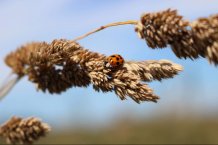Articles

Harlequin ladybird. Image courtesy of Jordan Jones
Early intervention could be key to battling invasive species
An international team of ecologists has carried out the first global meta-analysis of the characteristics and size of invasive alien species’ impacts on native species as invaders become more abundant.
The study, published in Proceedings of the National Academy of Sciences, suggests that early conservation interventions may often be required to protect native species from the harmful effects of invasive species.
Invasive species are animals or plants that have become established in habitats and regions where they are not normally resident, and which cause damage to native species and ecosystems.
While the strong negative impacts of invasive species have long been known, it was not known at what rate these impacts accumulate during the different stages of an invasion.
“Knowing this is critical to appropriately managing invasive species, because limited conservation resources need to be targeted effectively at the right stage of an invasion, to limit impacts on native biodiversity, and to exert maximum control on invasive species,” explains University of Liverpool ecologist Dr Raj Whitlock, who co-designed the study.
The research team, which was led by Bethany Bradley at the University of Massachusetts Amherst, analysed findings from 1,258 case studies from 201 research papers and found that impacts of invasive species on native species tends to be greatest at early stages in an invasion, when the invasive species are present in low numbers.
Dr Whitlock adds: “In many cases, once an invasive species has increased in abundance, the damage has already been done. This suggests that conservation management that aims to limit the impacts of invasive species and protect native plants and animals is best used early during biological invasions.”
Dr Regan Early, of the Centre for Ecology and Conservation on Exeter’s Penryn Campus in Cornwall, said: “It's a surprise that the impact of invasive species can be so high when they are just starting to colonise a new area.
“It means that we should be concerned about newly arriving invasives, not just the really widespread ones.”
The researchers also investigated whether the trophic position of an invasive species—its position in the ecosystem’s food chain relative to the native species—affected the shape of native species responses.
They found that invasive animals tended to have greatest negative effects on native species when they were higher up the food chain than the native species.
The extent of negative impacts caused by invasive plant species did not depend on invasive species abundance, suggesting that for these invasive species, conservation management could be an effective control measure at any stage during an invasion.
Finally, the researchers investigated how invasive species affect the diversity of coexisting populations (communities) of native animals and plants.
The results show that invasive species alter native communities most strongly by changing the abundance of their constituent species. Effects on native species number (species richness), via local extinction, were weaker.
Dr Whitlock concludes: “Our study establishes important principles for how invasive species impact on native species abundance and diversity through the course of a biological invasion. The findings are likely to be valuable in understanding the mechanisms of invasions and the demographic processes that underpin them.”
The work was supported by the Albert and Elaine Borchard Foundation and also involved researchers from the University of New Hampshire, the Universities of California, Riverside and Irvine, the Memorial University of Newfoundland, the University of Exeter, France’s Université de Picardie Jules Verne and Spain’s Estación Biológica de Doñana, Seville.
Date: 1 May 2019
